I have a project to design a negative DC regulator.
I have a batter of 48Vdc with 50ah so I want to regulate the voltage from -48vdc to -12vdc without affecting the current of 50ah. Please I need help anyone help me a diagram of that circuit or which is relating to my project or a advice. Remember am stepping down negative voltage.
I have a batter of 48Vdc with 50ah so I want to regulate the voltage from -48vdc to -12vdc without affecting the current of 50ah. Please I need help anyone help me a diagram of that circuit or which is relating to my project or a advice. Remember am stepping down negative voltage.

